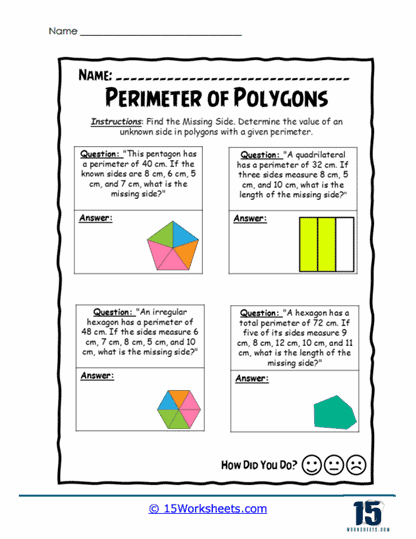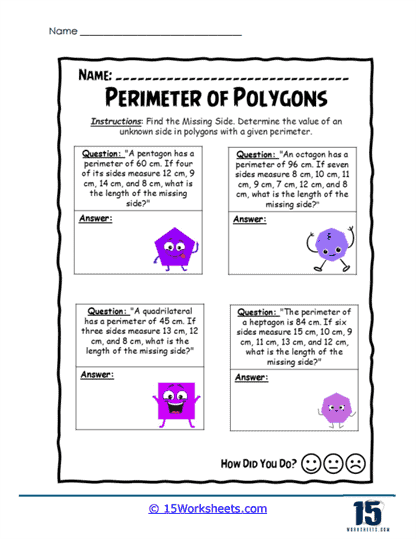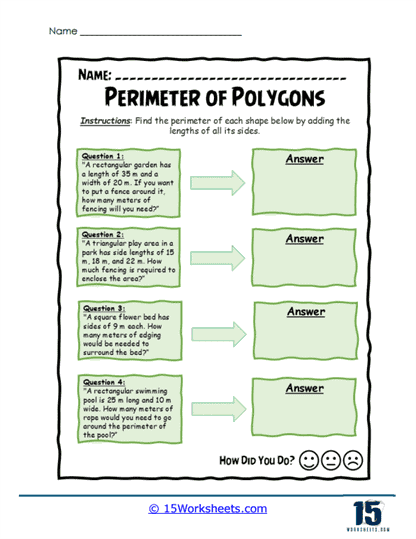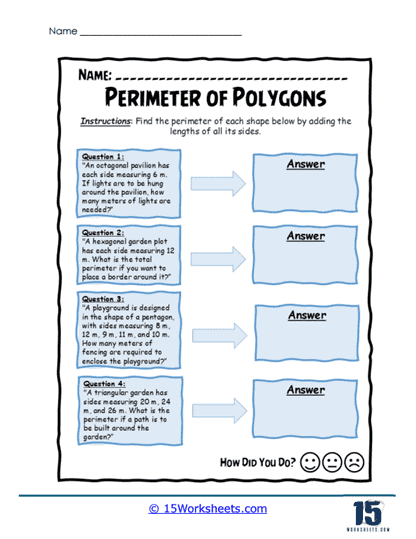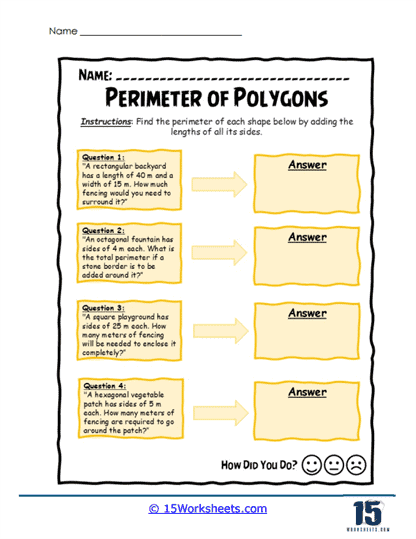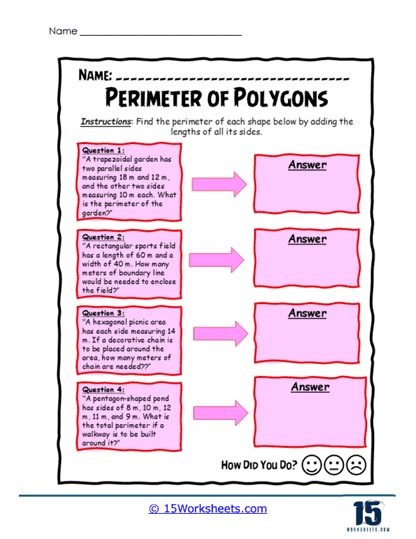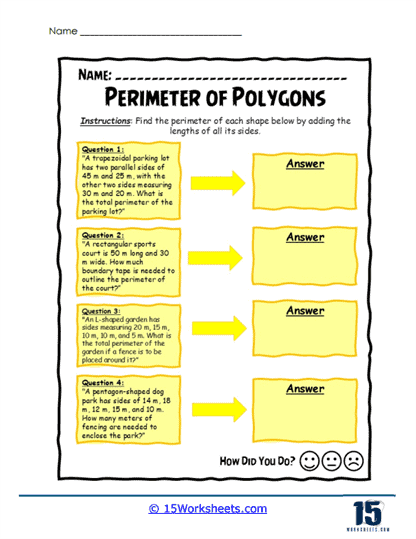Polygons Worksheets
About Our Perimeter of Polygons Worksheets
Understanding the perimeter of polygons is a fundamental skill in geometry, essential for solving real-world problems and building a strong mathematical foundation. This collection of Perimeter of Polygons Worksheets provides students with engaging and structured practice in calculating the perimeter of various polygonal shapes, from basic triangles and quadrilaterals to complex multi-sided figures. Designed for students at different grade levels, these worksheets cater to beginners who need step-by-step guidance as well as advanced learners who benefit from challenging word problems and real-world applications.
Calculating perimeter is a practical skill used in everyday life. Architects and engineers determine the perimeter of structures before construction. Gardeners and landscapers measure perimeters to install fences or lay pathways. Even when buying materials like molding, wire, or carpeting, knowing how to calculate perimeter ensures accuracy and efficiency. These worksheets help students bridge the gap between theoretical math and its real-world applications, making learning more meaningful.
How to Find the Perimeter of Polygons
To find the perimeter of a polygon, add the lengths of all its sides. A polygon is a closed figure with straight edges, such as triangles, quadrilaterals, pentagons, and more. If all sides are given, simply sum them up to get the total perimeter. For regular polygons, where all sides are equal, use the formula P = n x s, where n is the number of sides and s is the length of one side. If some side lengths are missing, use given angles, geometric properties, or the Pythagorean theorem (for right-angled polygons) to determine them before summing up all the sides.
Each worksheet in this collection is structured to reinforce key mathematical concepts. Some focus on straightforward perimeter calculations where students add up the side lengths of regular and irregular polygons. Others present word problems that encourage students to think critically about how perimeter applies in real-life situations. Special worksheets challenge students with missing side problems, where they must use logic and reasoning to determine unknown measurements based on given information. Additionally, the collection includes worksheets on unit conversions, ensuring students become comfortable working with different measurement units such as inches, feet, centimeters, and meters.
To deepen students’ mathematical understanding, the collection also includes worksheets that extend beyond basic perimeter calculations. Some worksheets incorporate coordinate geometry, where students use ordered pairs to calculate distances and determine the perimeter of polygons plotted on a graph. Others introduce algebraic perimeter problems, requiring students to solve for unknown variables before computing the total perimeter. By integrating these advanced problem-solving exercises, students develop both arithmetic fluency and algebraic reasoning, preparing them for more complex mathematical challenges in higher grades.
To make learning even more interactive, some worksheets incorporate visual and hands-on activities. Cut-and-measure exercises encourage students to physically manipulate paper polygons, reinforcing the concept of perimeter through tangible experience. Digital versions of these worksheets allow students to practice on interactive platforms, using drag-and-drop tools to build their understanding dynamically. For collaborative learning, group activities and peer challenges encourage students to discuss problem-solving strategies, fostering both teamwork and mathematical communication skills.
These worksheets are crafted with versatility and adaptability in mind, catering to diverse learning styles and educational needs. Whether used in traditional classroom settings, as homework assignments, for test preparation, or within homeschool curriculums, these worksheets provide structured and engaging practice for students at various levels. Teachers can incorporate them into lesson plans for guided instruction, helping students build foundational skills before progressing to independent problem-solving. Meanwhile, homeschoolers and self-learners will appreciate the clear, step-by-step examples and logical layout, which make learning accessible without requiring constant supervision. Each worksheet is carefully designed to reinforce key concepts while allowing students to work at their own pace, fostering both confidence and mastery of perimeter calculations.
To further support students and educators, the worksheets include answer keys for immediate feedback and self-assessment. This feature allows learners to quickly identify mistakes, understand where they went wrong, and refine their problem-solving strategies. For teachers, the answer keys make grading more efficient and provide a useful reference when explaining concepts to students. Additionally, differentiated worksheets ensure that learners of all levels-whether beginners needing extra guidance or advanced students seeking more complex challenges-can find exercises that match their skill set. With varying difficulty levels, these worksheets can be seamlessly integrated into different learning environments, promoting both individual progress and collaborative problem-solving.
This collection is conveniently available in PDF format, making it easy to view, download, and print for immediate use. The digital format ensures that high-quality, neatly formatted materials are accessible to students, teachers, and parents anytime, anywhere. Whether printed for hands-on practice or used in a digital classroom for paperless learning, these worksheets offer flexibility in how they are utilized. This accessibility is especially beneficial for educators who need quick, reliable resources to supplement their lesson plans or for parents seeking additional practice materials to support their children’s learning at home. The ease of access eliminates logistical barriers, ensuring that all students can benefit from structured, high-quality math practice.
Beyond just preparing students for academic success, these worksheets help bridge the gap between theoretical math and real-world applications. By engaging in structured perimeter calculations, students gain a deeper appreciation for the importance of measurement in everyday life. Whether estimating materials for a home project, planning a garden layout, or working in fields like engineering, architecture, and design, understanding perimeter is a practical skill with real-world relevance. The worksheets provide scenarios that encourage students to think critically about how mathematical concepts apply beyond the classroom, fostering problem-solving skills that will serve them in various careers and daily tasks.
Instead of viewing perimeter calculations as rote memorization, students learn to approach problems with curiosity and logical reasoning. By progressively working through different worksheet levels, they experience firsthand how persistence leads to improvement. This gradual skill-building approach not only enhances their mathematical proficiency but also nurtures a sense of accomplishment and confidence in tackling more advanced math challenges. Through structured practice and real-world connections, this collection empowers learners to see math as a valuable and applicable tool for success.









